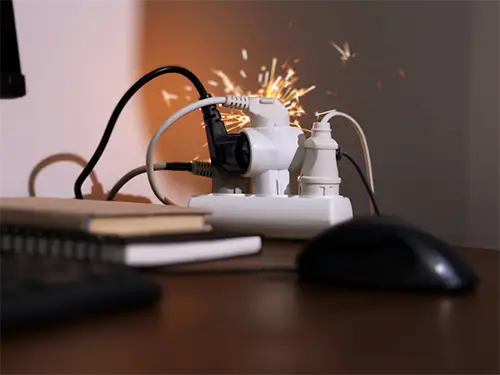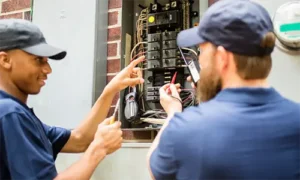 Circuit overload occurs when the demand for electricity exceeds a circuit’s designed capacity. This situation can cause a range of issues, from damaged appliances to power outages and even fire hazards.
Circuit overload occurs when the demand for electricity exceeds a circuit’s designed capacity. This situation can cause a range of issues, from damaged appliances to power outages and even fire hazards.
The most common reasons for overloads include excessive use of high-power appliances, old or faulty wiring, and a lack of understanding about how much power a circuit can safely handle.
This article explains the basics of circuit overloads, offers practical tips to prevent them, and explores electrical upgrades as long-term solutions for maintaining a safe and efficient electrical system.
Key Takeaways
- Circuit overload happens when electrical demand exceeds the circuit’s capacity.
- Common causes include high-power appliance use, old wiring, and misjudging circuit capacity.
- Prevent overloads by managing appliance usage, inspecting equipment, and upgrading wiring.
- Dedicated circuits and modern circuit breakers reduce overload risks.
- Professional electricians can identify and resolve persistent issues.
What is a Circuit Overload and How Does It Happen?
A circuit overload occurs when an electrical circuit draws more power than it is designed to handle. This causes the circuit breaker to trip, cutting off power to prevent damage or overheating. For instance, plugging in multiple high-wattage devices like a microwave, toaster, and coffee maker into a single kitchen outlet can easily overload the circuit.
Modern appliances often draw more electricity than older systems were built to support. This problem is especially common in older homes where wiring systems may not meet today’s energy demands. Misjudging a circuit’s capacity can lead to frequent trips, appliance damage, or even dangerous situations like fires.
How to Prevent Circuit Overload
Preventing circuit overload involves understanding your system’s capacity, managing energy usage, and maintaining your electrical system. Each of these steps plays an important role in avoiding overloads and the risk of electrical damage.
Understand Circuit Capacity
To prevent overloading, it’s important to know how much electricity your circuits can safely handle. Start by checking the wattage tags on your appliances, which indicate their energy demands. Most circuit breakers display their capacity in amps or watts, providing a reference point for safe usage.
By matching appliance usage to your circuit’s capacity, you can avoid overwhelming the system. For example, high-power appliances like washing machines or space heaters should not share a circuit with other devices.
Unplug Energy-Draining Appliances
Many household appliances, such as computers, TVs, kettles, and toasters, consume a lot of power even when not in active use.
Unplugging these devices when they are not needed reduces standby power consumption and helps avoid unnecessary electrical circuit overloads. This simple practice not only prevents overloads but also extends the lifespan of your appliances.
Scheduling appliance usage to avoid running multiple high-demand devices at the same time is another effective way to manage electrical loads.
Inspect Appliances
Damaged appliances can pose serious safety risks and contribute to circuit overloads. Regularly inspect cords for fraying, exposed wires, or other visible damage. If an appliance shows signs of wear, stop using it immediately and have it repaired or replaced.
Keeping appliances in good condition not only enhances safety but also ensures they operate efficiently, minimizing unnecessary electrical demands.
Invest in Energy-Saving Appliances
Switching to energy-efficient appliances is another practical way to reduce the risk of circuit overloads. These appliances are designed to consume less power while delivering the same performance as traditional models.
Energy Star-rated devices, for example, lower the overall power demand on your circuits and contribute to reduced energy bills. Trusted resources like government energy guides can help you identify models that meet your household’s needs.
Get an Electrical Safety Evaluation
If overloads persist despite your efforts, the issue may stem from underlying problems such as faulty wiring or outdated systems. A professional electrician can conduct a thorough evaluation to identify the root cause and recommend appropriate solutions.
Addressing these issues promptly prevents recurring problems and ensures your home’s electrical system operates safely.
Solutions for Frequent Circuit Overloads
 When circuit overloads happen regularly, more significant measures may be needed to protect your home and appliances.
When circuit overloads happen regularly, more significant measures may be needed to protect your home and appliances.
Install Dedicated Circuits
High-power appliances such as air conditioners, electric ranges, and washing machines should be connected to dedicated circuits. These circuits are designed to handle the energy demands of individual devices, preventing them from overloading shared circuits.
By isolating high-wattage appliances, you create a safer and more reliable electrical system.
Upgrade Your Circuit Breaker
Circuit breakers are central to managing electrical loads. Older breakers may struggle to handle the demands of modern appliances, leading to frequent trips or failures. Upgrading to a modern circuit breaker enhances your system’s ability to manage energy and provides additional safety features.
If your home still uses a fuse box, replacing it with a circuit breaker is a crucial safety improvement.
Rewiring Your Home
Homes built decades ago often have wiring systems that are inadequate for current energy needs. Whole-house rewiring ensures that your electrical system can handle today’s appliances and provides an opportunity to address any existing safety concerns. This investment enhances safety and capacity, making it a practical long-term solution for homes with outdated wiring.
Mister Sparky Can Help Prevent Circuit Overload
 Circuit overloads can lead to serious problems if left unaddressed. Mister Sparky provides expert electrical services, including safety evaluations, circuit breaker upgrades, and whole-house rewiring.
Circuit overloads can lead to serious problems if left unaddressed. Mister Sparky provides expert electrical services, including safety evaluations, circuit breaker upgrades, and whole-house rewiring.
If you’re in the Tampa, FL area, trust Tampa’s on-time electrician to keep your home safe and efficient. Call today or schedule an appointment online for professional assistance.
FAQs About Preventing Circuit Overload
Preventing circuit overload requires careful attention to your electrical system and appliance use. Below are common questions and answers to help you understand how to manage your circuits effectively.
Why does my circuit breaker trip frequently?
Frequent trips indicate an overloaded circuit or underlying wiring issues. Reducing the load on the circuit or consulting an electrician can resolve the problem.
How can I calculate my circuit’s load capacity?
Multiply your breaker’s amp rating by 120 volts (standard U.S. voltage). Use less than 80% of this total for safe operation.
Do extension cords prevent circuit overloads?
No, extension cords do not reduce the load on a circuit. They are temporary solutions and can introduce fire risks if overused.
What signs indicate my wiring needs an upgrade?
Flickering lights, frequent breaker trips, and outdated wiring systems like knob-and-tube are signs that your home may need rewiring.
Are older homes more at risk for circuit overloads?
Yes, older homes often have wiring systems that cannot handle the demands of modern appliances.
Final Thoughts
Understanding circuit capacity, managing appliance use, and investing in energy-efficient devices are essential steps to prevent circuit overload. For older homes or ongoing problems, electrical upgrades can help. Dedicated circuits, modern breakers, and whole-house rewiring improve safety and efficiency in the long run.
For professional help, trust Mister Sparky, Tampa’s on-time electrician, to address all your electrical needs. Contact them today for a safer, more reliable home.